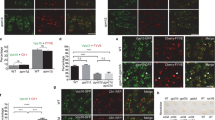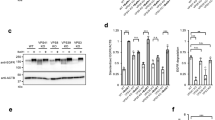Abstract
Membrane proteins with transmembrane domains (TMDs) that contain polar residues exposed to the lipid bilayer are selectively sorted into multivesicular bodies (MVBs) and delivered to the yeast vacuole. Sorting of some, although not all, proteins into these structures is mediated by ubiquitination. We have identified a transmembrane ubiquitin ligase, Tul1, that is resident in the Golgi apparatus and is required for the ubiquitination of proteins with polar TMDs, including vacuolar proteins such as carboxypeptidase S. We suggest that Tul1 provides quality control, identifying misfolded membrane proteins and marking them for transport to endosomes and degradation in the vacuole.
This is a preview of subscription content, access via your institution
Access options
Subscribe to this journal
Receive 12 print issues and online access
$209.00 per year
only $17.42 per issue
Buy this article
- Purchase on Springer Link
- Instant access to full article PDF
Prices may be subject to local taxes which are calculated during checkout







Similar content being viewed by others
Accession codes
References
Sato, K., Sato, M. & Nakano, A. Rer1p as common machinery for the endoplasmic reticulum localization of membrane proteins. Proc. Natl Acad. Sci. USA 94, 9693–9698 (1997).
Bonifacino, J. S., Cosson, P., Shah, N. & Klausner, R. D. Role of potentially charged transmembrane residues in targeting proteins for retention and degradation within the endoplasmic reticulum. EMBO J. 10, 2783–2793 (1991).
Munro, S. Localization of proteins to the Golgi apparatus. Trends Cell Biol. 8, 11–15. (1998).
Lewis, M. J., Nichols, B. J., Prescianotto-Baschong, C., Riezman, H. & Pelham, H. R. Specific retrieval of the exocytic SNARE Snc1p from early yeast endosomes. Mol. Biol. Cell 11, 23–38 (2000).
Scheiffele, P., Roth, M. G. & Simons, K. Interaction of influenza virus haemagglutinin with sphingolipid-cholesterol membrane domains via its transmembrane domain. EMBO J. 16, 5501–5508 (1997).
Zaliauskiene, L. et al. Down-regulation of cell surface receptors is modulated by polar residues within the transmembrane domain. Mol. Biol. Cell 11, 2643–2655 (2000).
Reggiori, F., Black, M. W. & Pelham, H. R. Polar transmembrane domains target proteins to the interior of the yeast vacuole. Mol. Biol. Cell 11, 3737–3749 (2000).
Sato, K., Sato, M. & Nakano, A. Rer1p, a retrieval receptor for endoplasmic reticulum membrane proteins, is dynamically localized to the Golgi apparatus by coatomer. J. Cell Biol. 152, 935–944 (2001).
Munro, S. An investigation of the role of transmembrane domains in Golgi protein retention. EMBO J. 14, 4695–4704 (1995).
Rotin, D., Staub, O. & Haguenauer-Tsapis, R. Ubiquitination and endocytosis of plasma membrane proteins: role of Nedd4/Rsp5p family of ubiquitin-protein ligases. J. Membr. Biol. 176, 1–17 (2000).
Beck, T., Schmidt, A. & Hall, M. N. Starvation induces vacuolar targeting and degradation of the tryptophan permease in yeast. J. Cell Biol. 146, 1227–1238 (1999).
Helliwell, S. B., Losko, S. & Kaiser, C. A. Components of a ubiquitin ligase complex specify polyubiquitination and intracellular trafficking of the general amino acid permease. J. Cell Biol. 153, 649–662 (2001).
Katzmann, D. J., Babst, M. & Emr, S. D. Ubiquitin-dependent sorting into the multivesicular body pathway requires the function of a conserved endosomal protein sorting complex, ESCRT-I. Cell 106, 145–155 (2001).
Reggiori, F. & Pelham, H. R. Sorting of proteins into multivesicular bodies: ubiquitin-dependent and -independent targeting. EMBO J. 20, 5176–5186 (2001).
Urbanowski, J. L. & Piper, R. C. Ubiquitin Sorts Proteins into the Intralumenal Degradative Compartment of the Late-Endosome/Vacuole. Traffic 2, 622–630 (2001).
Black, M. W. & Pelham, H. R. A selective transport route from Golgi to late endosomes that requires the yeast GGA proteins. J. Cell Biol. 151, 587–600 (2000).
Becherer, K. A., Rieder, S. E., Emr, S. D. & Jones, E. W. Novel syntaxin homologue, Pep12p, required for the sorting of lumenal hydrolases to the lysosome-like vacuole in yeast. Mol. Biol. Cell 7, 579–594 (1996).
Odorizzi, G., Babst, M. & Emr, S. D. Fab1p PtdIns(3)P 5-kinase function essential for protein sorting in the multivesicular body. Cell 95, 847–858 (1998).
Ellison, M. J. & Hochstrasser, M. Epitope-tagged ubiquitin. A new probe for analyzing ubiquitin function. J. Biol. Chem. 266, 21150–21157 (1991).
Swaminathan, S., Amerik, A. Y. & Hochstrasser, M. The Doa4 deubiquitinating enzyme is required for ubiquitin homeostasis in yeast. Mol. Biol. Cell 10, 2583–2594 (1999).
Causton, H. C. et al. Remodeling of yeast genome expression in response to environmental changes. Mol. Biol. Cell 12, 323–337 (2001).
Hofmann, R. M. & Pickart, C. M. Noncanonical MMS2-encoded ubiquitin-conjugating enzyme functions in assembly of novel polyubiquitin chains for DNA repair. Cell 96, 645–653 (1999).
VanDemark, A. P., Hofmann, R. M., Tsui, C., Pickart, C. M. & Wolberger, C. Molecular insights into polyubiquitin chain assembly: crystal structure of the Mms2/Ubc13 heterodimer. Cell 105, 711–720 (2001).
Galan, J. & Haguenauer-Tsapis, R. Ubiquitin lys63 is involved in ubiquitination of a yeast plasma membrane protein. EMBO. J. 16, 5847–5854 (1997).
Terrell, J., Shih, S., Dunn, R. & Hicke, L. A function for monoubiquitination in the internalization of a G protein-coupled receptor. Mol. Cell 1, 193–202 (1998).
Weissman, A. M. Themes and variations on ubiquitylation. Nature Rev. Mol. Cell Biol. 2, 169–78 (2001).
Dunn, R. & Hicke, L. Domains of the Rsp5 ubiquitin-protein ligase required for receptor- mediated and fluid-phase endocytosis. Mol. Biol. Cell 12, 421–435 (2001).
Wang, G. et al. Localization of the Rsp5p ubiquitin-protein ligase at multiple sites within the endocytic pathway. Mol. Cell Biol. 21, 3564–3575 (2001).
Wooding, S. & Pelham, H. R. The dynamics of Golgi protein traffic visualized in living yeast cells. Mol. Biol. Cell 9, 2667–2680 (1998).
Vida, T. A. & Emr, S. D. A new vital stain for visualizing vacuolar membrane dynamics and endocytosis in yeast. J. Cell Biol. 128, 779–792 (1995).
Babst, M., Sato, T. K., Banta, L. M. & Emr, S. D. Endosomal transport function in yeast requires a novel AAA-type ATPase, Vps4p. EMBO J. 16, 1820–1831 (1997).
Lewis, M. J., Rayner, J. C. & Pelham, H. R. A novel SNARE complex implicated in vesicle fusion with the endoplasmic reticulum. EMBO J. 16, 3017–3024 (1997).
Jelinsky, S. A. & Samson, L. D. Global response of Saccharomyces cerevisiae to an alkylating agent. Proc. Natl Acad. Sci. USA 96, 1486–1491 (1999).
Travers, K. J. et al. Functional and genomic analyses reveal an essential coordination between the unfolded protein response and ER-associated degradation. Cell 101, 249–258 (2000).
Roth, F. P., Hughes, J. D., Estep, P. W. & Church, G. M. Finding DNA regulatory motifs within unaligned noncoding sequences clustered by whole-genome mRNA quantitation. Nature Biotechnol. 16, 939–945 (1998).
Bays, N. W., Gardner, R. G., Seelig, L. P., Joazeiro, C. A. & Hampton, R. Y. Hrd1p/Der3p is a membrane-anchored ubiquitin ligase required for ER-associated degradation. Nature Cell Biol. 3, 24–29 (2001).
Gardner, R. G., Shearer, A. G. & Hampton, R. Y. In vivo action of HRD ubiquitin ligase complex: mechanisms of endoplasmic reticulum quality control and sterol regulation. Mol. Cell. Biol. 21, 4276–4291 (2001).
Letourneur, F. & Cosson, P. Targeting to the endoplasmic reticulum in yeast cells by determinants present in transmembrane domains. J. Biol. Chem. 273, 33273–33278 (1998).
Levkowitz, G. et al. c-Cbl/Sli-1 regulates endocytic sorting and ubiquitination of the epidermal growth factor receptor. Genes Dev. 12, 3663–3674 (1998).
Rocca, A., Lamaze, C., Subtil, A. & Dautry-Varsat, A. Involvement of the Ubiquitin/Proteasome System in Sorting of the Interleukin 2 Receptor beta Chain to Late Endocytic Compartments. Mol. Biol. Cell 12, 1293–1301 (2001).
James, P., Halladay, J. & Craig, E. A. Genomic libraries and a host strain designed for highly efficient two-hybrid selection in yeast. Genetics 144, 1425–1436 (1996).
Shih, S. C., Sloper-Mould, K. E. & Hicke, L. Monoubiquitin carries a novel internalization signal that is appended to activated receptors. EMBO J. 19, 187–198 (2000).
Acknowledgements
We thank E. Hettema for the ubiquitin–GFP construct, and R. Haguenauer-Tsapis, M. Lewis, M. Black, S. Siniossoglou and K. Madura for advice and reagents. F. R was supported by the Swiss National Science foundation and by the European Molecular Biology Organization.
Author information
Authors and Affiliations
Corresponding author
Rights and permissions
About this article
Cite this article
Reggiori, F., Pelham, H. A transmembrane ubiquitin ligase required to sort membrane proteins into multivesicular bodies. Nat Cell Biol 4, 117–123 (2002). https://doi.org/10.1038/ncb743
Received:
Revised:
Accepted:
Published:
Issue Date:
DOI: https://doi.org/10.1038/ncb743
This article is cited by
Construction and Characterization of UBC4 Mutants with Single Residues Swapped from UBC5
Cell Biochemistry and Biophysics (2020)
Identification of SAMT family proteins as substrates of MARCH11 in mouse spermatids
Histochemistry and Cell Biology (2012)
E3 Ubiquitin Ligases in Protein Quality Control Mechanism
Molecular Neurobiology (2012)
Palmitoylation: policing protein stability and traffic
Nature Reviews Molecular Cell Biology (2007)
Retrotranslocation of a viral A/B toxin from the yeast endoplasmic reticulum is independent of ubiquitination and ERAD
The EMBO Journal (2006)



